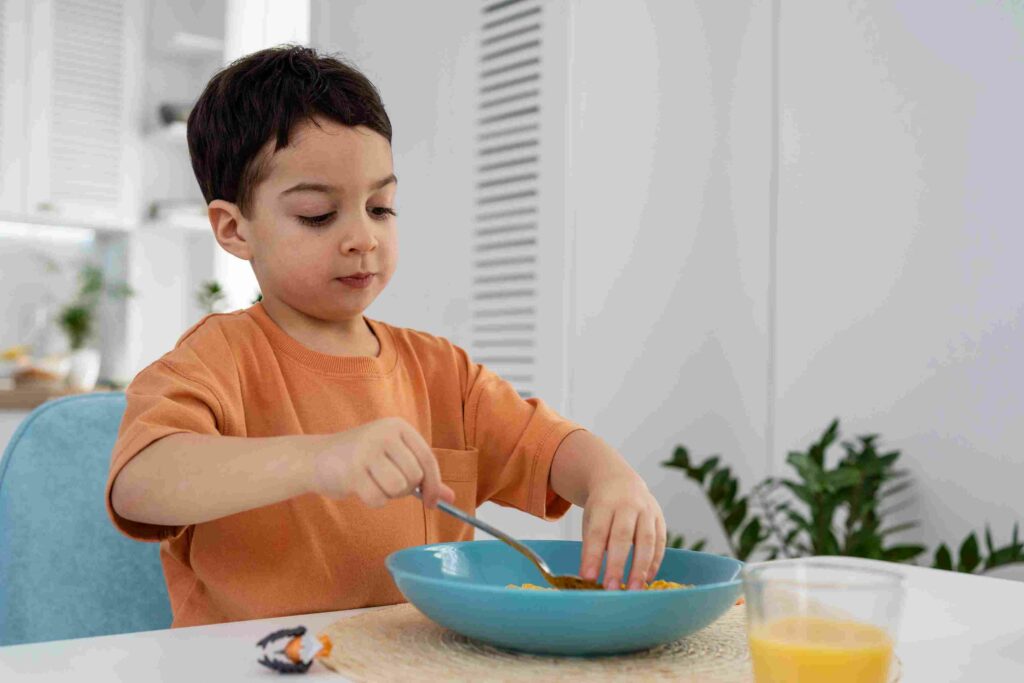Get Your Family To Enjoy the Meals You Cook For Them – Sign up to get access to a FREE Summer Special Meal Plan, a Seasonal Grocery List & a Seasonal Recipe
As parents, our innate desire is to make sure our kids eat well & stay healthy. However, in the contemporary world, this has evolved into a significant undertaking. Despite having access to an abundance of resources like grains, nuts & millets, providing our children with the same level of purity and simplicity we experienced during our own childhood, especially in terms of their overall growth and nutritional needs, has become progressively challenging.
Unfortunately, alternatives to the primary food sources are rife with unhealthy, junk food options. It is disheartening to realize that even so-called “healthy” foods often contain refined ingredients like sugar, maida, and harmful oils like palm oil. A quick glance at the ingredients list of packaged foods often reveals a long list of preservatives.
Our grandparents and ancestors, who enjoyed long and healthy lives, provide a compelling example. Several lifestyle factors contributed to their longevity, such as their engagement in agricultural work, residing in clean and environmentally friendly surroundings, and limited exposure to chemicals. However, a significant aspect of their well-being was attributed to their dietary habits, particularly the diversity of foods they consumed.
Their primary sustenance comprised an array of grains, extending beyond just wheat or rice, which regrettably constitutes nearly 60-80% of our daily diets today. They incorporated millets, legumes, sprouts, various cereals, dry fruits, seeds, and an abundance of herbs and spices into their meals.
Are Millets Healthy?
Millets are nutritionally superior to rice and wheat in terms of proteins, minerals, and vitamins. They are high in nutrition and dietary fibre. They serve as a good source of micronutrients and phytochemicals.
Millets contain 7-12% protein, 2-5% fat, 65-75% carbohydrates and 15-20% dietary fibre.
The essential amino acid profile of the millet protein is better than various cereals such as maize. Millets contain fewer cross-linked prolamins, which may be an additional factor contributing to the higher digestibility of the millet proteins.
The presence of phytochemicals in millet grains has a positive effect on human health by lowering the cholesterol and phytates in the body.
Health Benefits Of Eating Millets
Millets are also recognized for their potential nutraceutical health benefits, which encompass a range of advantages. Some of these benefits include
- Promoting digestive system health
- Reducing cholesterol levels
- Preventing heart disease
- Mitigating the risk of diabetes
- Lowering the chances of developing cancer
- Enhancing energy levels while improving muscular function
Example Of Millets
Some common millets used in India include
- Bajra (pearl millet)
- Nachani (finger millet)
- Kangni (foxtail millet)
- Koden (koda millet)
- Bhagar (little millet)
- Jhangora (barnyard millet)
- Jowar (sorghum)
How Millet Benefits Children’s Nutrition

Millet’s nutrient density provides children with the energy needed for their active lifestyles. The protein content supports muscle and tissue development, while minerals like magnesium and phosphorus contribute to bone health and overall growth.
The high fibre content in millet aids digestion by preventing constipation and promoting a healthy gut microbiome. Regular bowel movements are crucial for children’s comfort and overall well-being.

For children with gluten sensitivities or allergies, millet is a great nutritious gluten-free alternative to wheat and other gluten-containing grains, allowing them to enjoy a varied diet.
Millet’s low GI can help regulate blood sugar levels, reducing the risk of energy spikes and crashes in children. This can be particularly beneficial for those prone to mood swings or difficulty concentrating.
Millet is incredibly versatile and can be incorporated into a wide range of dishes, from porridge and pancakes to salads and casseroles. This versatility makes it easier for parents to introduce millet into their children’s diets in an appealing way.
Precautions When Eating Millets
While millet offers numerous nutritional benefits, there are some considerations and precautions to keep in mind when incorporating it into children’s diets. Like any food, millet should be consumed in moderation as part of a balanced diet. Overconsumption of any single food can lead to nutritional imbalances.
Similar to other grains and seeds, millets contain phytates, which can inhibit the absorption of certain minerals like iron and zinc. To mitigate this, you can soak, sprout, or ferment millet before cooking to reduce phytate levels. Although millet is generally well-tolerated, some individuals may be allergic to it.
Always be cautious when introducing new foods to a child’s diet and monitor for any adverse reactions. Properly cooking millet is essential to ensure its digestibility. Undercooked millet can be tough and difficult to digest, so follow cooking instructions carefully.
The use of millet can indeed benefit children’s nutrition in numerous ways. However, it’s crucial to remember that no single food can provide all the necessary nutrients for a child’s growth and development.
A balanced and varied diet, including a range of grains, fruits, vegetables, and proteins, is key to ensuring optimal nutrition for children. Incorporating millet as part of this diverse diet can contribute positively to their overall well-being and health.


















